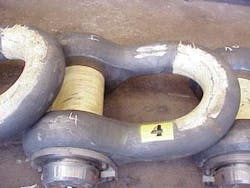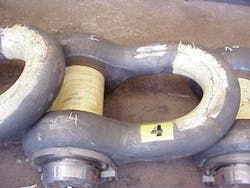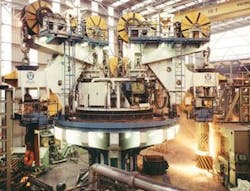Vicinay adapting chain grades, designs for evolving mooring demands
Spain’s Vicinay Cadenas, one of the world’s longest-established anchor chain groups, has made tremendous strides to keep up with the industry’s widespread shift to deeper water operations.
In the late 1980s, Vicinay Cadenas branched into studless chain. Its first application was theWest Vision semisubmersible in the Norwegian North Sea, still in operation today. In conventional studlink chain, the studs have a tendency to work loose over time, putting long-term performance at risk. With studless chain, the incidence of fatigue-induced, premature fractures is low, in turn lessening inspection requirements. Other advantages include lower weight, better elasticity, and only a modest risk of corrosion, compared to studlink. Vicinay says it was the sole producer of studless chain from 1989-1994.
In the mid-1990s, the company next introduced Variable Geometry and Weight (VGW) chain. Vicinay designed VGW to offer greater flexibility to mooring system designers. The basic idea is to produce tailor-made chains, studded or studless, that allow the moorings to be configured to suit the confines of a particular project. Typical scenarios include:
- Saving weight in the mooring lines - without impacting the chains’ mechanical properties - to permit greater payload capacity in the platform or rig
- Designing the chain links to transit through the customer’s motorized equipment (i.e., winches or pallets) while retaining the same weight and diameter
- Incorporating increased abrasion and corrosion resistance, improved durability or fatigue life without any corresponding increase in the chain’s weight - this might be achieved by increasing the chain pitch, or the diameter of the links
- Designing the chain to achieve a more favorable price.
To realize these advantages, Vicinay invites mooring designers to work closely with its specialists in Bilbao to evaluate options available for each project. This collaboration extends to subsequent manufacturing and certification of the produced chain. Golar-Nor was one of the first clients to accept this approach.
Golar Nor sanctioned VGW for thePetrojarl I FPSO for application in the North Sea. The end result was a chain with the same weight, but a larger diameter (to compensate for uncertainties over the anticipated level of corrosion).
“Another such project was Lundin’sIsis FPSO offshore Tunisia,” Eduardo Lopez, engineering director, says. “Here the client was concerned about the chain twisting, as in this location, the vessel would be positioned in front of the prevailing wind. Lundin wanted links with the same resistance, but with added weight to increase the torsion capacity. It was no problem for us to meet these requirements.”
ConocoPhillips also chose VGW for the shallow waterBelanak FPSO, moored with 132-mm studless chain, featuring pitch geometry of 5*D and width geometry of 3.35*D. “Here fatigue and corrosion were the main issues,” Lopez says. “To meet the client’s request for bigger chain, and at no extra price, we fabricated a longer chain, but with 7% fewer links. It took a long time to convince the client that this approach would work, but this we achieved through a fatigue test at our factory, which was followed by approval from ABS.”
Petrochina also chose VGW for the Betara development complex, where Vicinay designed two sets of studless chains with 127 mm and 117 mm diameter., both with a pitch of 5*D and a width geometry of 3.35*D.
Classification societies including ABS, DNV, and Lloyds Register have approved the VGW technique, but have also requested Vicinay to stage seawater fatigue tests on full-scale chain. These tests are normally conducted at the Labein technological center nearby in Bilbao.
Chain upgrades
As drilling and production moves into increasingly deeper waters, the mooring designer must cater for longer line lengths in numerous ways. These include increasing chain link sizes to withstand mechanical stresses, widening the corrosion margin, and extending fatigue life. These demands are liable to pile weight onto mooring systems comprising chain of conventional link sizes or grades. The net result can be an increased payload on the floating rig or platform, and therefore increased construction costs.
Five years ago, Vicinay anticipated these problems and started developing alternative chains graded R4S and R4S+, based on its experience formulating Grade 4. As a starting point, the company experimented with the chemical composition used in Grade 4 steel, working to improve its characteristics without degrading its durability or corrosion resistance.
Recently, in collaboration with the University of Bilbao’s Metallurgical Department and Spanish steel-maker Sidenor, Vicinay developed R4S steel chain with a mechanical resistance of up to 960 Mpa, which is an 11% increase on the MBL level achieved by previous R4 grades, and R4S+, which offers resistance up to 1,000 Mpa. This latter value represents a 17% increase on the MBL level achieved by previous R4 grades.
Vicinay has also performed full-scale water tests on 149-mm R4S+ chain using in-house test equipment, applying the following parameters:
- Testing frequency: 0.5 Hz
- Loads: max. 2,943 kN; min. 491 kN; average, 1,717 kN
- Wave form: Sine
- Salt-in-water concentration: 35.64 g/liter
- Average saltwater temperature: 19.5° C.
Under these conditions, the predicted chain fatigue life would be 163,592 cycles, according to API RP2SK March 1997, and the figure should be 172,610 cycles, according to DNV OSE301 Position Mooring June 2001. The actual result Vicinay obtained from a test on three R4S+ links last November in Bilbao was 1,575,250 cycles.
Vicinay says that due to these characteristics, R4S and R4S+ can offer reduced chain weight (around 16-17% in R4S+) through decreasing the diameter without impacting resistance, improved tensile homogeneity, and increased abrasion resistance. The company is currently supplying 2,100 tonnes of R4S+ studless chain in 127- and 117-mm diameters for Atlantia Offshore’s Independence Hub semisubmersible platform in Mississippi Canyon block 920 in the Gulf of Mexico and a similar grade of 70-mm studlink chain for Noble’s semisubmersible drilling rigTherald Martin. ABS has classed both installations.
Other Vicinay innovations over the years include LLLC, which is a special link designed jointly with spar specialist Aker Rauma to work with messenger chains during installations (though not for permanent moorings). This allows the contractor to use a quick, easily operated and safely detachable link with high working capacity, while retaining the same outer geometry as a conventional link. It also includes thermally-sprayed aluminum and ceramic coatings, provide extra corrosion and abrasion resistance to selected parts of the mooring chain. Application is performed in a continuous process involving high temperature spraying for the aluminum coating and high-velocity oxygen fuel for the abrasion coating. Both were the end product of a year-long R&D program also involving Labein, the University of the Basque Nation, and Spain’s National Institute of Aerospace Techniques. Shell’s Na Kika project in the GoM was the first offshore application. More recently, Amerada Hess’Triton FPSO in the UK North Sea received a special ceramic coating to reduce wear on an H shackle connector.
Manufacturing techniques
The company has developed and installed numerous techniques and machines to aid the production process at its plant in Bilbao. These include:
- Geminis cell, which fabricates continuously chain up to 185-mm diameter, in all grades, from conversion of the bar into links to the point where the chain enters the heat treatment furnace. The cell also allows simultaneous fabrication and inspection of two chains without the need for any connectors
- P-Man, which predicts failures in the machines, and avoids unforeseen problems arising from the manufacturing schedule
- Quality weld, which provides automated control of the flash butt weld system in real time, allowing a six-strong team of Vicinay technicians to follow and record over 40 parameters of the welding process, with up to 100 data points per second or parameter to aid subsequent analysis. All the data (including non-destructive testing) are computerized, allowing each individual chain link to be traced following installation offshore
- Quality Heat, which provides automated control of heat treatment for a unit of chain throughout the treatment period. It is a double quenching and tempering machine, Vicinay installed in 1996, which can work continuously without stopping for 50 days at a time, after which point shut-down is mandatory for water tank cleaning. Vicinay says it is the only chain maker to have such a facility
- Proof load machine, which handles up to 2,700 metric tons. It is a high precision chain length measurement system, that restricts the maximum deviation to 0.07% over the total chain length
- A laboratory featuring one machine for tensile tests, used to analyze a chain’s mechanical properties, and another machine for impact tests
- Preliminary inspection (not demanded by classification societies) to avoid rejection following heat treatment
- An ultrasonic inspection robot that provides 100% inspection of the weld cross area.
“The industry is fully aware that the strength of mooring chains is potentially also one of the weakest links,” says Lopez. “All the services we provide allow us to deliver homogeneous and reliable links in all our mooring chains, thereby avoiding weak links.” Vicinay also makes its own shackles and chain accessories, easing the trial fit between the chains and the shackles.
“In emergency situations, Vicinay can produce replacement chains. The last proof of this response capability came last summer when Hurricane Ivan struck numerous installations in the GoM. We were able to replace the chain of one rig on an urgent basis without impacting concurrent orders for other customers.”
Vicinay maintains a workforce of around 200 personnel in Bilbao and can handle up to 35 projects per year, which is just as well in light of the offshore sector’s sudden upturn. Most of its activity at present is in the GoM, West Africa, Southeast Asia, and the North Sea, with the Brazilian sector handled by its joint venture company Brasilamarras.


